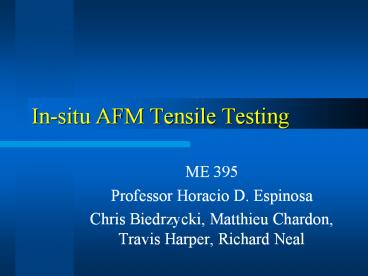In-situ AFM Tensile Testing PowerPoint PPT Presentation
Title: In-situ AFM Tensile Testing
1
In-situ AFM Tensile Testing
- ME 395
- Professor Horacio D. Espinosa
- Chris Biedrzycki, Matthieu Chardon, Travis
Harper, Richard Neal
2
Micron Scale Mechanical Properties
- Once structures enter microscale, laws of macro
mechanics no longer dominate mechanical response - Samples approach size scale of grains and
dislocations, also dominated by surface effects - Multimaterial interfaces, sharp corners in MEMS
devices require in-situ characterization - Devices in market require a high amount of
reliability, necessitating direct fatigue testing
methods
3
Advantages of In-Situ Testing
- Model entire range of behavior
- Differentiate elastic and plastic regimes
- Understand more than ultimate tensile strength
(UTS)
4
Similar Works
1
3
1
2 µm
No testing results
2
1) Mechanical Measurements at the Micron and
Nanometer Scales, Knauss, Huang
2) Microtensile Tests with the Aid of Probe
Microscopy for the Study of MEMS Materials,
Knauss, Chasiotis
3) MEMS Fatigue Testing to Study Nanoscale
Response, Fisher, Labiossiere
5
Testing stage
- Polysilicon specimen
- Integrated during fabrication
- Pulled by mass
- Actuators move mass when voltage applied
- Force measured by capacitive sensor
- Strain measured by DIC
From Zhu et. al., 2003
6
ANSYS Modeling of System
The maximum load deliverable by the loading
device is 100 mN
From Zhu et. al., 2003
7
Polysilicon Sample
Properties Young's Fracture Method
Properties Modulus Strength Method
Properties (Gpa) (GPa) Method
MUMPs21 136-174 1.3-2.8 tensile
MUMPs19 132 - tensile
Stress Concentrations - 1.3-1.5 tensile
Size Effect 154.1-159.6 1.51-1.67 tensile
Size Effect-doped - 2.0-2.8 tensile
Microcantilever 17420 2.80.5 bending
AFM deflection 17310 2.60.4 bending
Bulk 181-203 - indentation
Doped-Undoped 95-175 - indentation
4µm
10µm
From Prorok, et al. Vol 5, 2004.
8
Integrated in Chip
Yongs Chip
Chriss Quarter
9
Testing Setup
Difficult to land the cantilever on the test
specimen without repeatedly breaking tips
10
Atomic Force Microscopy (AFM)
- Benefits
- Very fine resolution (0.02nm)
- Variable scanning size/rate
- Risks
- Noise sensitivity, drift
- Constraints on sample size/mass
From Espinosa, Introduction to AFM and DPN,
ME395 Winter 2004
11
AFM Resolution
- Resolution
- Dimension 3100 512x512 pix
- JEOL 256x256 pix
- Digital Image Correlation (DIC) can interpret
change in position of a pixel by change in
grayscale pixel strength (from 1black to
255white). - Ideally, DIC can understand a resolution of
1/255th of a pixel
12
AFM Resolution
- Scan size (say, 1.0 µm) corresponding to 512
pixels - DIC resolution 1/255th of a pixel
- Theoretical (maximum) displacement resolution (a)
- If length of sample is 10?m, theoretical
resolution of strain is (b)
(a)
(b)
13
AFM Imaging Types
- Amplitude
Topography
Polysilicon pad imaged using D3100 AFM
14
AFM Imaging Types
- Amplitude
Topography
Polysilicon pad imaged using JEOL AFM
15
AFM Problems
- Adjustment of voltage, frequency for tip
- Sensitivity to dust/scratches
- Breakage of tip
- Crash of tip into sample
- Sensitivity of feedback control system
16
Digital Image Correlation
- No automatic compensation for drift
- Correlation on stationary samples
- Drift strain is only strain
- Used to generate correction factor
17
Digital Image Correlation (DIC)
- Example Illustrates DIC Capabilities
Sample Prior to Deformation
Error
X-X Tensile Strain
Y-Y Tensile Strain
Shear Strain
18
DIC Problems
- Out-of-plane Deformation
- Displacement Gradients
- Scanning Noise
19
DIC Resolution
- Displacement resolution of DIC is 1/255pix, much
smaller than the 0.512 pix minimum displacement
in pixels for the polysilicon at failure. - AFM/DIC should be able to display 0.512/(1/255),
or 130 images for the range of displacement to
failure based on ideal resolution/largest scan
area. - Note actual resolution smaller than ideal,
fewer images result. - Smaller scan areas will provide more images, and
thus finer understanding of the change in strain
over time.
20
Digital Image Correlation (DIC)
- Sample DIC images from 10x10µm sample using D3100
AFM
21
Digital Image Correlation (DIC)
- Sample DIC images from 10x10µm sample using JEOL
5200 AFM
22
AFM Comparison
The EPIC AFM, scanned in amplitude mode, yields
the best results
23
Experimental Design
- Optimal Designs
- Computer generated
- Best with respect to a particular criterion
- D-Optimal minimizes l(XX)-1l
- Places points at regions of greatest standard
error
24
Experimental Design
Robust Design All relevant information obtained
using less than half the required experiments in
a full factorial study
H0 µ1 µ2 H1 µ1 ? µ2 a P(type I error)
P(reject H0 l H0 true) ß P(type II error)
P(fail to reject H0 l H0 is false) Power 1 - ß
25
Experimental Design
Standard Order 19 Removed (Above 3.5)
Outliers distort the analysis of variance Outlier
when residuals /- 3s
26
Experimental Results
Significant Factors A, B, AB R-Squared .776
27
Experimental Results
28
In Conclusion
- Optimal testing conditions for drift reduction
- JEOL 5200 AFM (Forced Feedback)
- Amplitude Scan
- Tapping Mode
- High Scan Area
- Sample choice and scan rate effect drift rate
very little
29
In Conclusion
Optimized drift condition remains too large to
distinguish polysilicon strains from error 1
Strain at failure for polysilicon minimized
drift remains 100 of experimental strain With
current minimized strain values, brittle samples
cannot be assessed
30
Future Work
- Drift Effects Reduction Opportunities
- Appraiser Variation in DIC Analysis
- Environmental Effects
- Electromechanical Noise
- Temperature, Pressure, Humidity Variation
- Feedback Mechanism - Consider Image Repeatability
- Sample Ductility
31
Thank You For Your Time
- Questions?
- In-Situ AFM Tensile Testing Group
- Chris Biedrzycki, Matthieu Chardon, Travis
Harper, Richard Neal

